Beginning a Wind or Brass Instrument
The team here at WA Music Co. are often asked “when should my child begin learning a wind or brass instrument?” As a result, we have years of experience to answer this question!
Unlike string instruments, wind and brass instruments don’t usually come in different ‘sizes’ corresponding to the developing height of a child player. However, there are still some developmental factors to consider when starting a child on an instrument. Arm length, muscle development, finger dexterity, and facial muscle strength are all important to consider when a child begins an instrument.
However, if your small child is extremely keen to start learning a particular instrument, there are smaller alternatives and child-friendly instrument models that would suit a younger player, such as a curved headed flute and a Kinder French Horn.
Please note that all children are different and the below guidelines may not apply to your particular child. This is perfectly fine! If you feel you need more clarification for your particular circumstances, please speak to a qualified instrumental teacher or professional performer.
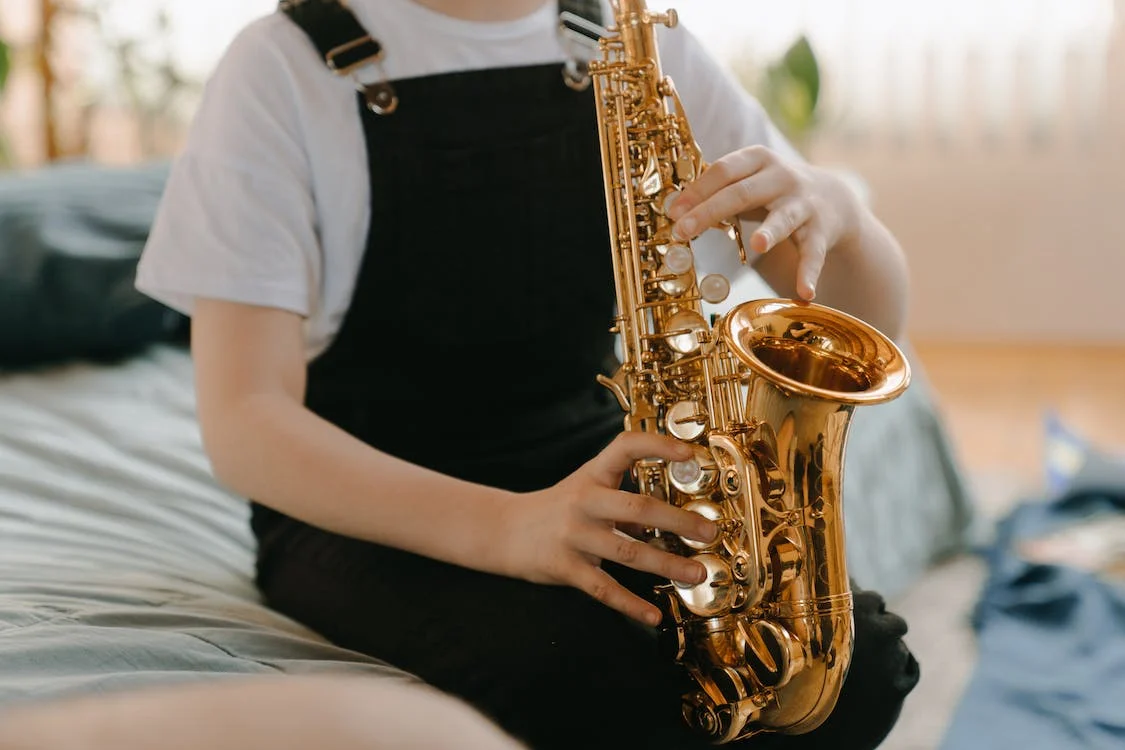
Flute
Generally, children can start learning the flute around 8 to 10 years old. At this age, they usually have the lung capacity, finger dexterity, and cognitive skills needed to begin learning a wind instrument.
While height is not a strict requirement, arm length is more important. Children should be able to comfortably extend their arms and fingers to reach the keys without strain. If they can hold the flute and reach the keys comfortably, they might be ready to start.
A flute generally measures around 67cm long, with the 40cm roughly where a child would place their right hand on the instrument. If a child holds their right hand up and out 40cm to the right of mouth and the angle of the elbow is 90 degrees or less, they are ready to learn on a flute.
If a child must reach to place their right hand 40cm to the right of their face, and the angle of the elbow is great than 90 degrees, the child may be better suited to a curved head flute. These flutes are designed to shorten the overall length of the flute by having the head curved around in a bed towards the player’s lips. To hire or purchase a curved head flute, check availability with us at sales@wamusic.com.au.

Oboe
Oboe is often introduced a bit later than other woodwind instruments due to its complexity and the unique embouchure (the way the lips and facial muscles are used to produce sound). Many oboe teachers recommend starting around 10 to 12 years old.
Oboes are generally 65 cm long and must be held at a 45 degree angle in front of the player to get proper reed placement in the embouchure. If a child places their right hand 40cm out in front of them, and the curvature of the elbow is flat or nearly so, the oboe will be too big for the child. Currently there are no smaller versions of the oboe manufactured for younger players available for hire.
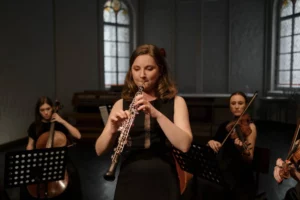
Clarinet
Starting the clarinet can typically begin around the same age as the flute, around 8 to 10 years old. Clarinets are roughly 66cm long but can be held close to the body of the child due to the single-reed mouthpiece and embouchure not requiring much of an angle. Neck straps for clarinet can be purchased for smaller children who struggle with the weight of the instrument.

Bassoon
Many bassoon teachers recommend that children be at least 12 years old to have hands big enough to reach the keys. Furthermore, a bassoon embouchure requires children to exert pressure with their front teeth to control the vibration of bassoon reeds, which isn’t practical for kids who have not yet grown permanent teeth.
Currently we do not have any smaller models of bassoon available for rent.
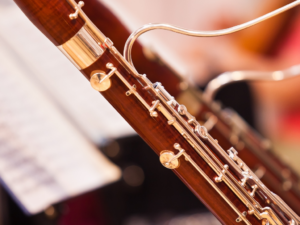
Saxophones
Many music educators recommend that children start learning the alto saxophone around 9 to 11 years old. At this age, children have typically developed enough lung capacity, finger dexterity, and cognitive skills to begin learning a wind instrument. Starting the tenor saxophone is often recommended around the same age as the alto saxophone. Children with the physical size and strength to comfortably hold and play the instrument can start learning the tenor saxophone.
Due to its larger size and weight, the baritone saxophone is usually introduced a bit later than the alto and tenor saxophones. Many music educators suggest starting the baritone saxophone around 11 to 13 years old.
All WA Music hire saxophones come with a neck strap to assist with the weight of the instrument.
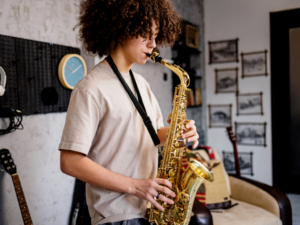
Trumpet
Children can begin to learn the trumpet from as young as 6, but many trumpeters begin learning the instrument between the ages of 8 and 10. Trumpets are made of brass and can become quite heavy after being held aloft for a period of time.
If a smaller child wishes to learn the trumpet, they could start out on the cornet instead. The cornet is very similar to the trumpet. It is tuned in the key of Bb and requires the same embouchure and valve fingerings. However, the cornet has a softer sound, is a physically shorter instrument, and is easier to hold.
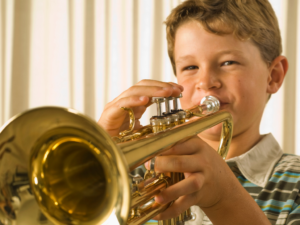
French Horn
Single Horn: Many French horn teachers recommend starting with a single French Horn around 9 to 11 years old. Learning on a single horn allows the student to focus on building fundamental skills before transitioning to a double horn. The single horn is lighter in weight and has less complex tubing than the double French Horn.
However, some smaller children may want to begin learning the horn with a Kinder Horn, which is suitable for children between 7 and 9 years old. Kinder Horns, also called 3/4 horns, have been wrapped more tightly than a full-size horn and have slightly less flare at the bell. The smaller size can be advantageous for a very young player or someone smaller in stature.
Double Horn: Transitioning to a double French Horn typically occurs a bit later, around 12 to 14 years old. The double horn has additional valves that allow for a broader range of notes and a smoother transition between the different registers.
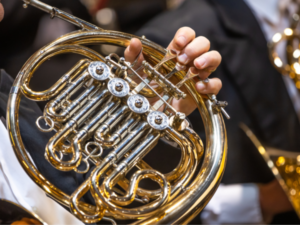
Trombone
Most music educators and instructors recommend that children start learning the trombone around the ages of 9 to 12. The trombone requires a certain amount of physical strength to hold and manipulate the instrument, especially for moving the slide. Starting around age 9 or 10 ensures that children have developed enough strength to handle the instrument with relative ease.
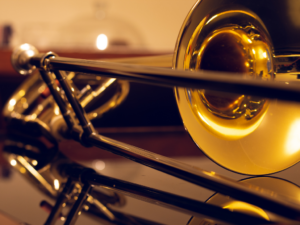
Baritone and Euphonium
The baritone is an excellent starter instrument for young brass players and adults. It is one of the larger brass instruments but still manageable for most children ages 7 and upwards. It is generally easier to learn once a pupil has started to develop their adult teeth.
Many students start on the baritone before the euphonium because it is a bit smaller and more manageable. The mouthpiece is also smaller, so it is a little easier to produce the sound. A baritone is lighter, has a brighter sound, and has three valves compared to the conically tubed, heavier Euphonium, which generally has either three or four valves.
The euphonium is a brass instrument that is similar to the baritone horn. The euphonium, like other brass instruments, requires a certain level of physical strength to hold and play comfortably. Children around age 9 or 10 are typically better equipped to handle the instrument’s weight and size.
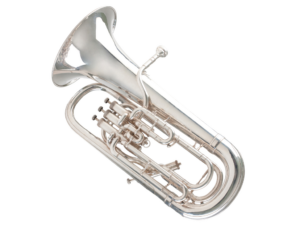
To Summarise…
| Instrument | Ideal Child Size/Age | Child Too Small? Try… |
| Flute | 8-10 years old | Curved-headed flute |
| Oboe | 10-12 years old | |
| Clarinet | 8-10 years old | |
| Alto/Tenor Saxophone | 9-11 years old | |
| Baritone Saxophone | 11-13 years old | Alto/Tenor Saxophone |
| Bassoon | 12 years old + | |
| Trumpet | Ages 6 and up | Cornet |
| Trombone | 9-12 years old | |
| Single French Horn | 9-11 years old | Kinder French Horn: 7-9 years old |
| Double French Horn | 12-14 years old | |
| Baritone | Ages 7 and up | |
| Euphonium | 9-11 years old | Baritone |
Got Any Questions?
The above information is a general guide only, and if your child doesn’t quite meet our criteria, that’s okay! Consulting a professional instrumentalist or instrumental teacher will give you a better idea about the specifics involved in beginning an instrument at a particular age.
If you have any questions about purchasing a beginner instruments, or hiring an instrument as a low-commitment alterative, contact us at sales@wamusic.com.au or (08) 9244 9559.
